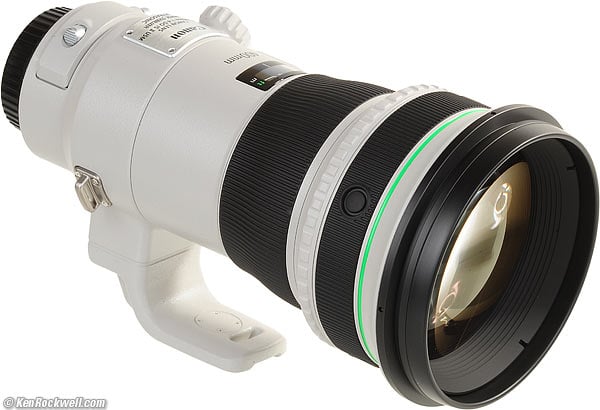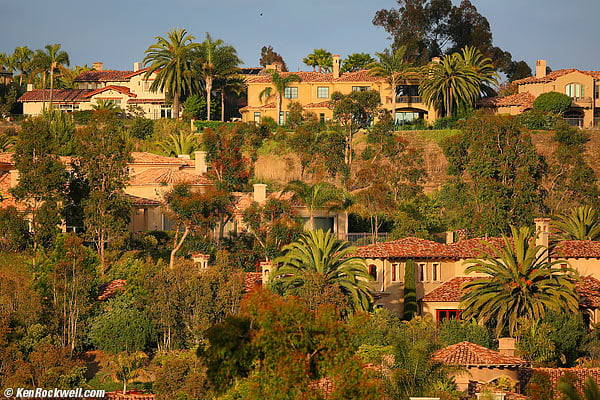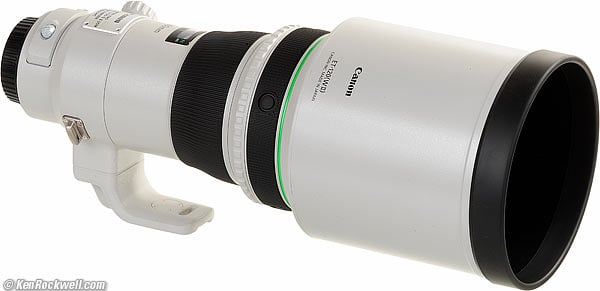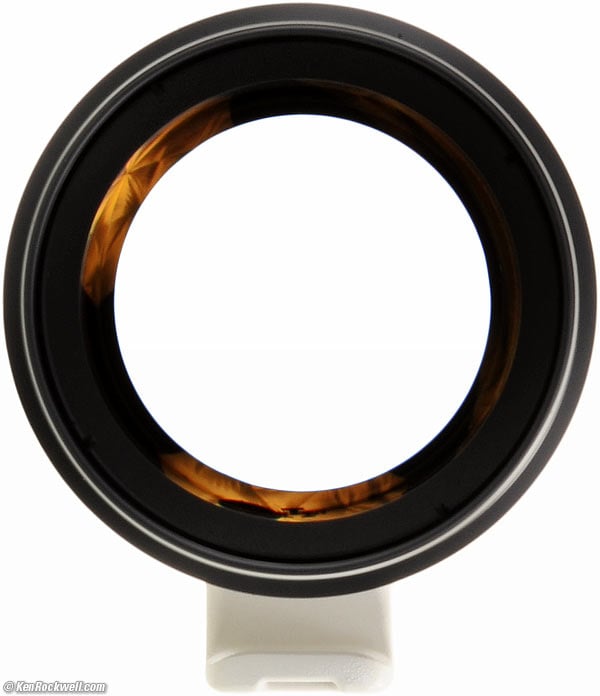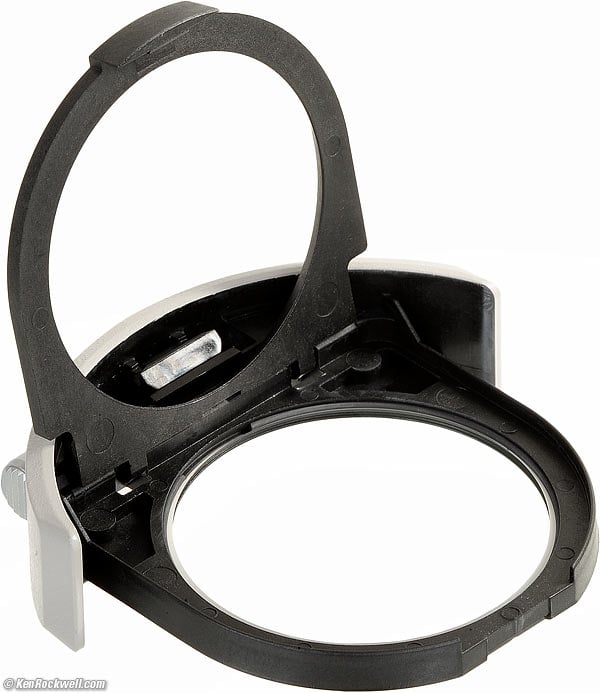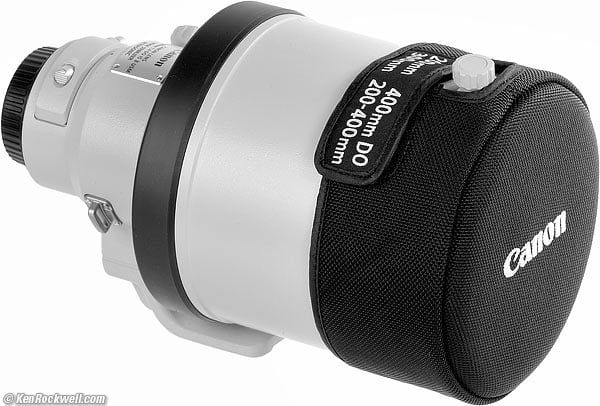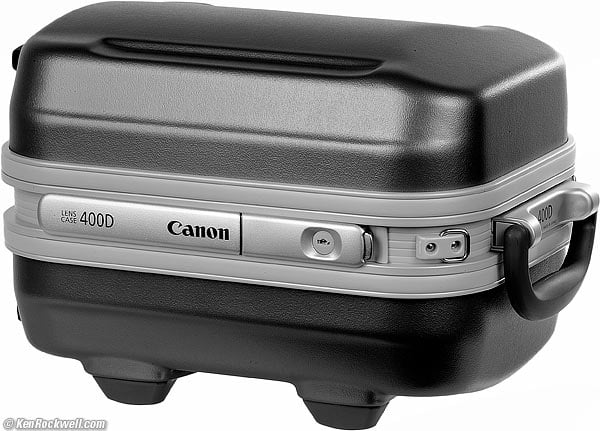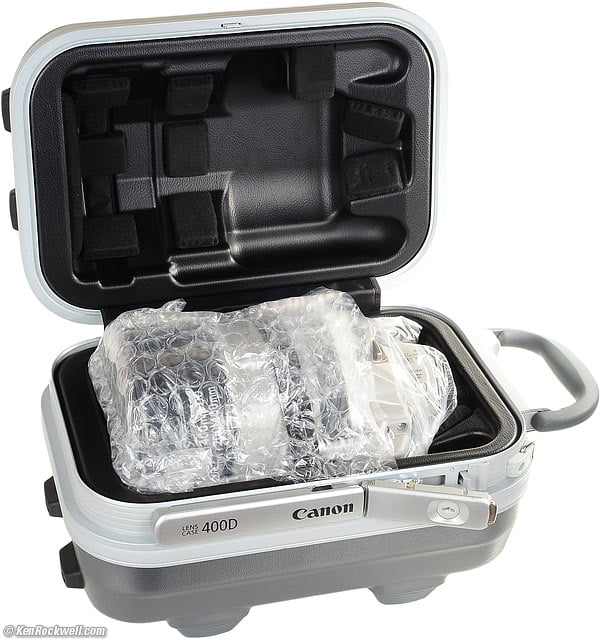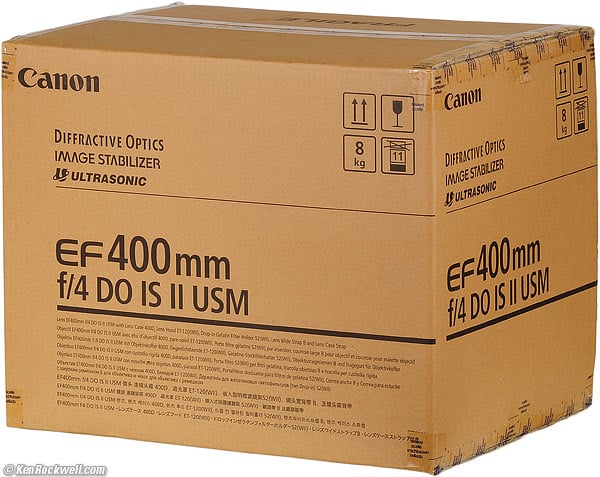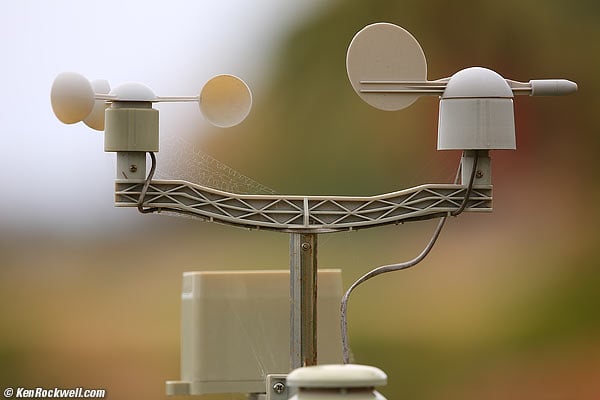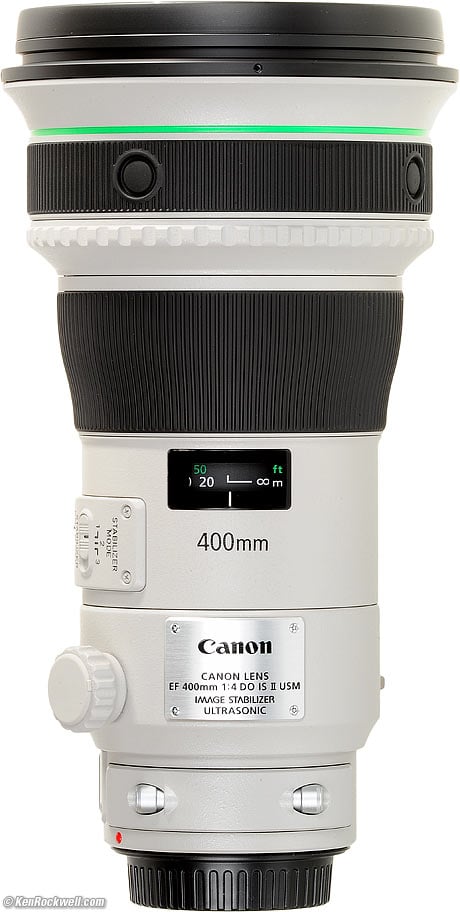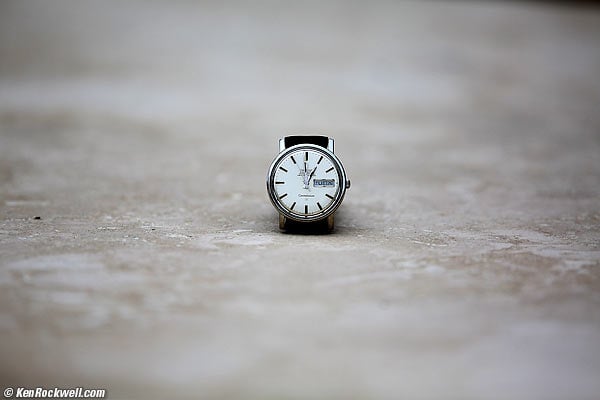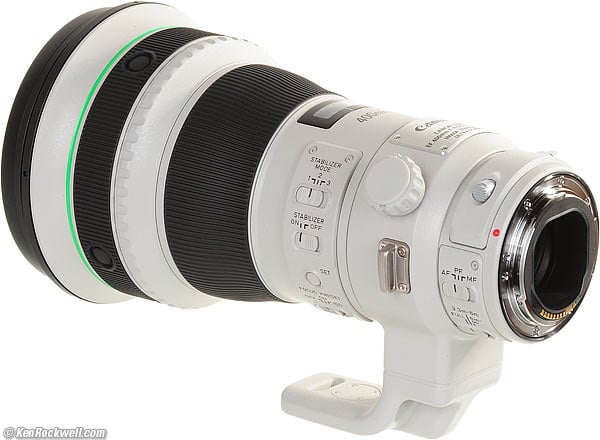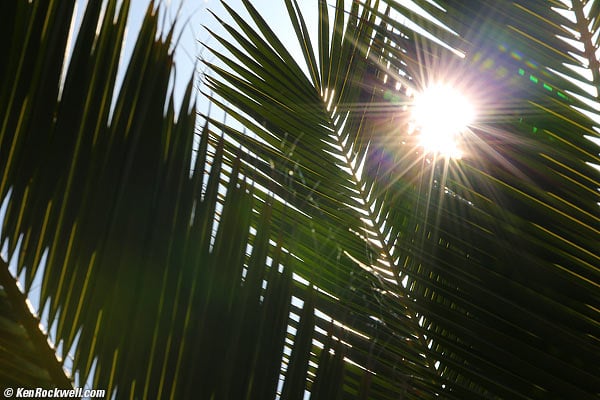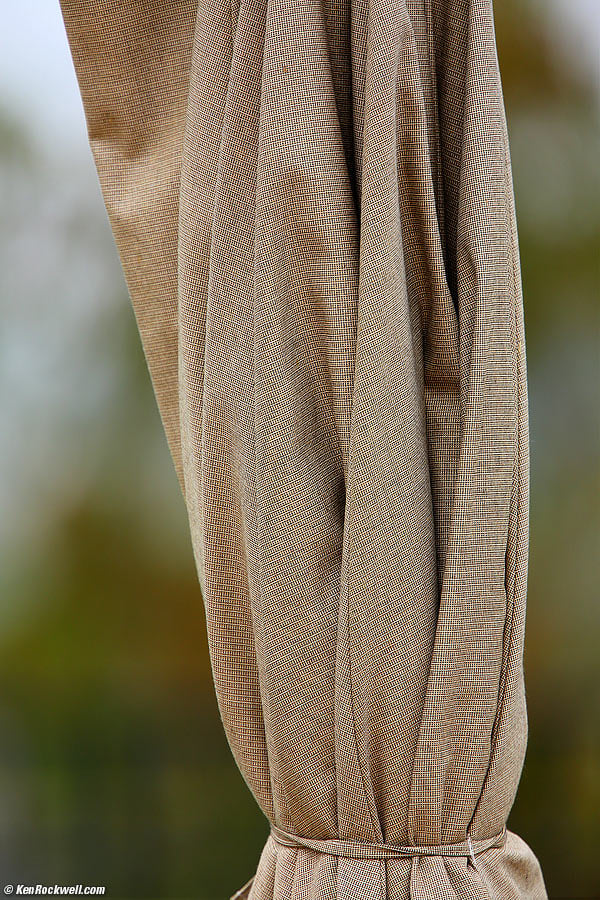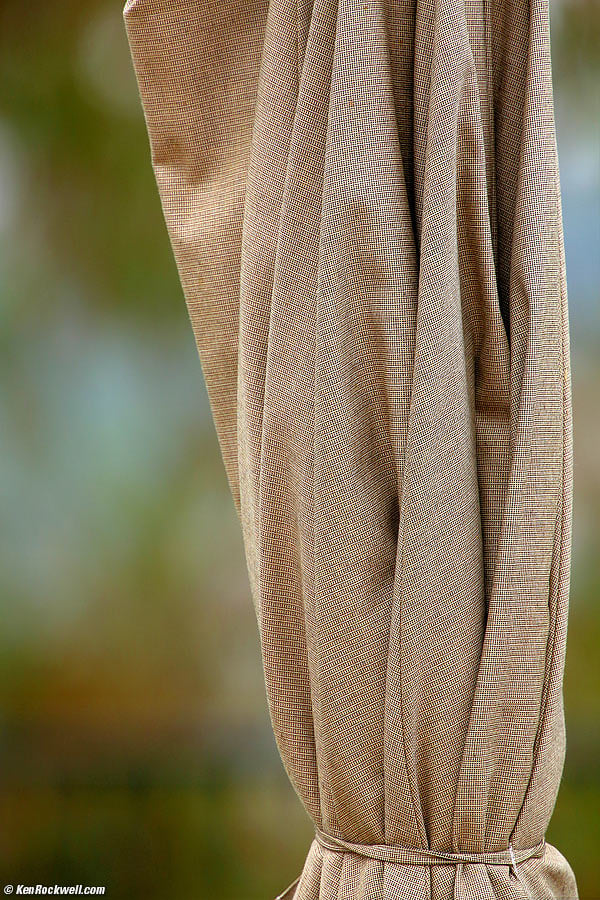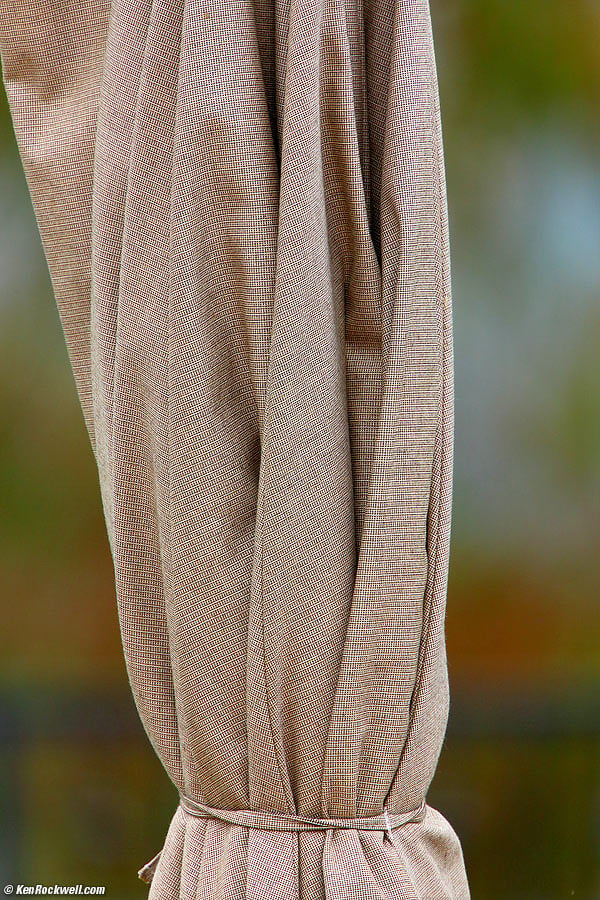Home Donate New Search Gallery Reviews How-To Books Links Workshops About Contact
Canon 400mm f/4 DO IS II
EF USM (2014-)
© 2015 KenRockwell.com. All rights reserved.
Sample Images Intro Specs Performance
Compared Usage Recommendations More
Canon EF 400mm f/4 DO IS II USM (Full-frame, 1.3x and and APS-C coverage, 52mm drop-in gel filter holder, 73.8 oz./2,090g, 11'/3.3m close focus, about $6,900). enlarge.
I got mine at Adorama; I'd also get it at Amazon or at B&H. This all-content, junk-free website's biggest source of support is when you use those or any of these links to approved sources when you get anything, regardless of the country in which you live. It helps me keep adding to this free website when you get anything through these links — but I receive nothing for my efforts if you take the chance of buying elsewhere. Thanks for your support! Ken.
May 2015 Canon Lenses Canon Reviews All Reviews
Why fixed lenses take better pictures
Sample Images top
Sample Images Intro Specs Performance
Compared Usage Recommendations More
Sevilla, España. (Canon 5D Mk III at Auto ISO 100, Canon 400mm f/4 DO II wide-open at f/4 at 1/800 hand-held, no lens profile.) Camera-original © JPG file.
Super-sharp from edge-to-edge, you can see every leaf on every tree. The dust speck in the sky is actually a bird in flight a mile away, and this is wide-open at f/4 where most lenses are at their softest!
Introduction top
Sample Images Intro Specs Performance
Compared Usage Recommendations More
This Canon 400mm f/4 DO IS II USM is an ultra high performance, ultra lightweight hand-holdable telephoto lens for every Canon DSLR and 35mm EOS camera.
It has fantastic optics, fast autofocus, fantastic Image Stabilization (IS) and top-notch build quality — all in a tiny, lightweight package. There is no downside, except for its relatively long minimum focus distance (3.3m/11 feet) and that its price matches its high performance.
I get autofocus even with two stacked teleconverters to 1,100mm, and its fantastic IS system lets me hand-hold it even at 1,100mm. At 400mm I get sharp shots at 1/20 of a second!
It is among Canon's sharpest lenses of all; the only lenses slightly sharper may be some of the other $10,000 ultra teles, otherwise this 400mm is sharper than any of Canon's black lenses, sharper than any of its zooms and sharper than any of its macro lenses.
While I prefer my new 100-400mm L II zoom for day-to-day general purpose use, this 400/4 DO is for people who need to shoot at 400mm or use teleconverters for the most reach, and still want the most reasonably-sized hand-holdable lens to carry all day.
While it comes in a big, hard case inside an even bigger cardboard box to justify the high price, the 400/4 DO II itself is shorter than my 100-400mm L II when set to 400mm! The 400 DO II is so light that I can shoot it one-handed for short periods of time.
This 400mm lens is more than just a super-sharp ultratelephoto, it's also a lens small enough and light enough that you'll actually carry it and use it, which is far better than my 15-pound Nikon 400mm f/2.8 AF-I that I haven't used in 15 years because it's too darn heavy.
Just grab the focus ring at any time for instant manual-focus override.
In addition to regular mechanical manual focus, a new PF (Power Focus) manual focus mode for video focuses silently and electronically as controlled by another ring (see Usage).
Oddly, the tripod collar doesn't come off.
As other DO lenses, this is not an L lens. Canon claims DO lenses are all that L lenses are, and then some. No big deal; this lens has enough alphabet soup as it is.
This is a lightweight lens, but it's not cheap like Nikon's all-plastic made-in-China 300mm f/4 Fresnel PF. This Canon 400mm has an all metal barrel and is made in Japan — and is still ultralight.
Format
This is a full-frame lens, so it works on all formats. It has been optimized for 35mm EOS and Full-frame digital, and of course works on 1.3x and 1.6x Canon cameras.
Full frame lenses are at their best on full-frame, which is how I will be reviewing it.
You can make the usual inferences when used on smaller sensors.
Compatibility
This works perfectly with every Canon EOS camera ever made, meaning every Canon DSLR and every Canon autofocus EOS 35mm camera made since 1987.
This means of course it works great on today's 5DS, 5D Mark III, 6D and Canon 7D Mark II, but I tried it and everything also works just as well on my original Canon EOS 650 from 1987!
Unlike lesser brands like Nikon where you take your chances, with Canon EF lenses, autofocus, power focus, image stabilization and preset focus all work just as well on Canon EOS cameras from any decade. Bravo Canon!
Extra Features
As a $7,000 lens, this lens offers the usual features, as well as these special ones not found in lesser lenses:
AF Lock buttons
Just hold any of the four AF Lock Buttons around the front of the lens to lock focus, for instance when recomposing or if your moving subject goes behind an obstruction for a moment.
Preset Focus Recall
It's easy to preset a focus distance, like home plate or your bird feeder, and regardless of where you're focussed, flick the knobby white ring at the front of the lens in either direction and the 400/4 DO II immediately returns to the preset focus distance.
Mechanical and Electronic Manual Focus
The focus moves anytime you move the focus ring.
A new "PF" focus mode for video lets you move the manual focus at two speeds electronically, as controlled by moving the big white knobby ring at the front of the lens.
The advantage of this new mode for video is that it's silent.
Best of all worlds, you can still move manual focus mechanically by turning the usual focus ring at the same time you're using the PF mode electronically.
Security Slot
Flip-up the plastic cover over the tripod collar locking knob and there's a security cable socket underneath.
Canon EF 400mm f/4 DO IS II with included hood. enlarge.
Specifications top
Sample Images Intro Specs Performance
Compared Usage Recommendations More
Name
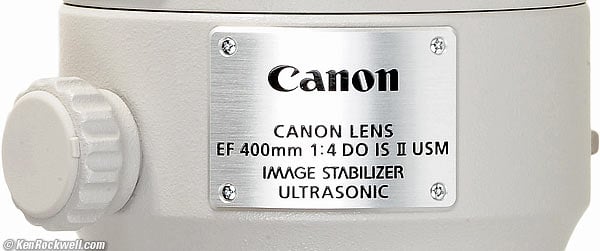
Canon EF 400mm f/4 DO IS II USM.
Canon calls this the CANON LENS EF 400mm f/4 DO IS II USM IMAGE STABILIZER ULTRASONIC.
EF means "electronic focus;" there is an autofocus motor inside the lens. All Canon lenses have been EF since 1987.
DO refers to Canon's fluff name of "Diffractive Optics," which they use instead of simply saying that this lens uses Fresnel elements to reduce weight. There's nothing diffractive about it; Canon just was afraid to say Fresnel and tries to use a fancier name instead. Historically Fresnel optics have only been used in lighthouses and stage lighting, but not image forming, and Canon is smart enough to know that most people wouldn't get it. Using Fresnel optics in a telephoto lens is brilliant, and only Canon had the technology to pull this off at first.
IS and IMAGE STABILIZER mean that you don't need a tripod.
II means that this is the second version of this lens.
USM and ULTRASONIC mean that this uses an UltraSonic focus Motor for near silent auto and manual focus.
Optics top

Canon EF 400mm f/4 DO IS II internal diagram. Glass, UD glass, aspherical element, Fresnel elements and the IS system.
18 elements in 12 groups.
One UD glass element.
One aspherical element.
Two Fresnel elements (a cemented Fresnel doublet).
Multicoated.
Internal focussing.
Here's a view through the lens looking at the sky (sorry for the tree branched on the left:
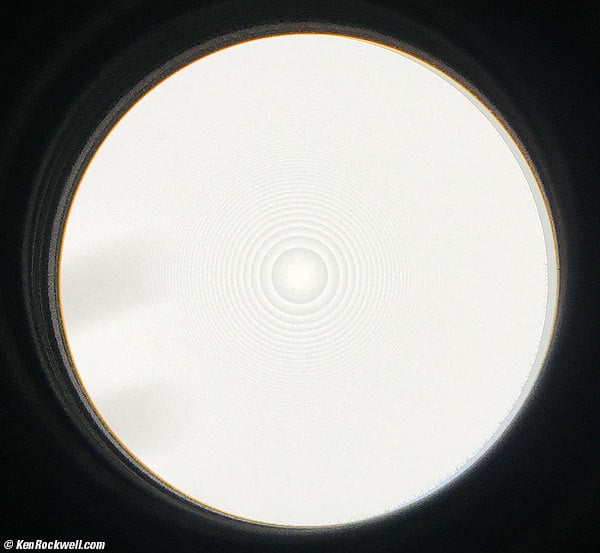
View of Fresnel element of Canon 400mm f/4 DO IS II.
No, I have no idea why it looks like this instead of being all 100% transparent.
Focal Length
400mm.
When used on an APS-C camera, it sees an angle of view similar to what a 600mm lens sees when used on an FX or 35mm camera.
Angle of View, full frame
6.2º diagonal.
3.5º vertical.
5.2º horizontal.
Diaphragm top
Canon 400mm f/4 DO IS II at f/4. (EF diaphragm not visible).
9 curved blades.
Stops down to f/32.
Close Focus top
11 feet (3.3m) from the image plane.
Maximum Reproduction Ratio top
1:7.7 (0.13x).
Extension Tubes and Converters top
See the Extension Tubes and Teleconverters sections in the Performance section.
Image Stabilizer top
Rated four stops improvement.
Works even with Teleconverters and Extension Tubes.
Hard Infinity Focus Stop? top
No.
Focus Scale top
Yes.
Depth-of-Field Scale top
No.
Infra-Red Focus Index top
No.
Filters top
Canon 52mm (W II) drop-in filter holder. bigger.
52mm (W II) drop-in gelatin filter holder included.
Optional 52mm (W II) Screw-in filter holder ($110).
Optional 52mm (W II) drop-in circular polarizer ($240).
Size top
Canon specifies 5.04" (128 mm) diameter by 9.16" (232.7 mm) extension from flange.
Weight top
73.75 oz. (4 lbs, 9-3/4 oz. or 2,090g), actual measured.
Canon specifies 74.1 oz. (2,100g).
Hood top
Reversible thumbscrew-lock ET-120 (W II).
Canon EF 400mm f/4 DO IS II with reversed ET-120 (W II) hood and E-145C front cap. enlarge.
Caps top
E-145C soft front cap and standard EOS rear cap.
Same caps as for 200/2, 300/2.8 and 200-400.
Tripod Collar top
The tripod collar never comes off.
It has positive clicks at 90º.
Case top
Canon 400D hard case. bigger.
Canon 400D hard case with lens wrapped as new. bigger.
Canon includes a very nice 400D hard case. It's built to take a beating, and has heavy feet on three sides.
Introduced top
September 2014.
Canon Model Names top
Complete kit: EF40040DIS2, which includes:
Case: 400D.
Hood: ET-120 (W II).
Soft front cap: E-145C.
Canon Model Numbers top
Complete kit: 8404B002. (8404B001 in Japan), which includes:
Case: 8405B001.
Hood: 4414B001.
Soft front cap: 4416B001.
JAN Numbers top
Complete kit: 4960999-977270, which includes.
Case: 4960999-977294.
Hood: 4960999-664941.
Soft front cap: 4960999-664958.
Included top
Lens with permanent tripod collar and ET-120 (W II) hood.
E-145C soft front cap and standard EOS rear cap.
400D case.
Big strap for case.
Strap for lens.
Price, USA top
2015 May
Complete system with lens, case, hood and caps: $6,900 (899,000 yen list price in Japan).
Replacement 400D hard case: $450 (48,000 yen list price in Japan).
Replacement ET-120 (W II) hood: $520 (52,000 yen list price in Japan).
Replacement E-145C soft front cap: $90. (8,000 yen list price in Japan).
Box
Box, Canon 400/4 DO II. bigger.
The box is a huge 15.5 x 29 x 14.2" (397 x 483 x 360mm) HWD triple-wall corrugated cardboard box. It's not clean and white; it's bare cardboard.
Inside the box are four white closed-cell foam blocks. These hold the hard case which lies inside a plastic bag with the paperwork taped to the outside of the bag. The straps for the case are packed with the white foam blocks, and the strap for the lens is packed inside the case with the lens.
I honestly believe that the lens could arrive undamaged if dropped from a jetliner. I estimate that this box' terminal velocity would be about 50 ~ 100 MPH, and with the combined cushioning of the outer box and inner hard case, for all I know the lens itself just might make it — especially if packed in yet another outer box as this one came to me from Adorama.
Performance top
Sample Images Intro Specs Performance
Compared Usage Recommendations More
Overall Focus Bokeh Coma Distortion
Ergonomics Extension Tubes Falloff
Filters Flare & Ghosts Focus Breathing
Color Fringes Image Stabilization Macro
Mechanics Sharpness Sunstars Teleconverters
Overall performance top
The Canon 400mm f/4 L is sharp and easy to use. Focus and Image Stabilization work flawlessly, as we'd expect from a $7,000 lens.
Focus performance top
Auto/Manual Switching
Just grab the ring anytime for instant manual-focus override.
AF Speed
AF is nearly instantaneous.
It's also very good with converters, see Teleconverters.
AF Accuracy
AF is always dead-on; shoot at f/4 and it's always perfect.
Bokeh performance top
Bokeh, the quality of out-of-focus areas as opposed to the degree of defocus, is superb.
Backgrounds get very soft, never distract and just melt away. That's why 400mm lenses are a top pro choice for portrait lenses.
Here's a full-frame sample:
Canon 400mm f/4 DO II bokeh at f/4. Camera-original © JPG file.
Coma performance top
I see no coma. It's sharp right out to the corners, even at f/4.
Distortion performance top
There is no visible distortion at any distance.
For more critical scientific use, use these values in Photoshop's Lens Distortion tool to correct the slight pincushion distortion:
100' (30m) |
-0.7 |
30' (10m) |
-0.7 |
11' (3.3m) |
-0.5 |
© 2015 KenRockwell.com. All rights reserved.
Ergonomics performance top
Canon EF 400mm f/4 DO IS II USM. bigger.
This lens is all about ergonomics; it's easy to hold and shoot. I even can shoot one-handed if I have to for short period.
Everything is where you want it. It's easy to set the Preset Focus without taking my eye from the finder.
The only weird thing is that the AF/PF/MF and Focus Limiter switches are farther back than you'd expect, so you have to take the camera down from your eye in order to set them.
Extension Tubes performance top
Canon suggests using manual focus with extension tubes.
Canon EF-12 (12mm long)
You can use the Canon EF-12 or Canon EF12 II, however all it does is shift your focus range to 2.753 ~ 13.407 meters, with a magnification range from 0.03x ~ 0.17x.
In other words, the EF12 is a waste of time unless you really need to get just 10% closer than you can without the tube.
Canon EF-25 (25mm long)
The Canon EF-25 or Canon EF25 II doesn't do much more.
It lets you focus from 2.362 ~ 6.638 meters, with magnifications of 0.07x ~ 0.22x.
I suspect you can stack extension tubes to get even closer.
Falloff (darkened corners) performance top
Falloff is completely invisible, even without a lens correction profile. See the shot at the top? It was made wide-open on full-frame.
I've greatly exaggerated this by presenting it against a gray background. In actual photography, it's invisible, and with a lens profile will be even less.
Canon 400mm f/4 falloff on full-frame, no correction.
© 2015 KenRockwell.com. All rights reserved.
|
Filters, Use with performance top
There's no way to use front or rear filters.
There is a drop-in holder with a round piece of multicoated glass that needs to stay. The instructions say leave the glass there even when you're using a gel; the optics are calculated to have it there.
Flare and Ghosts performance top
While you'd expect problems due to the Fresnel elements, I saw none. Here's how it looks under the Flashlight Test:
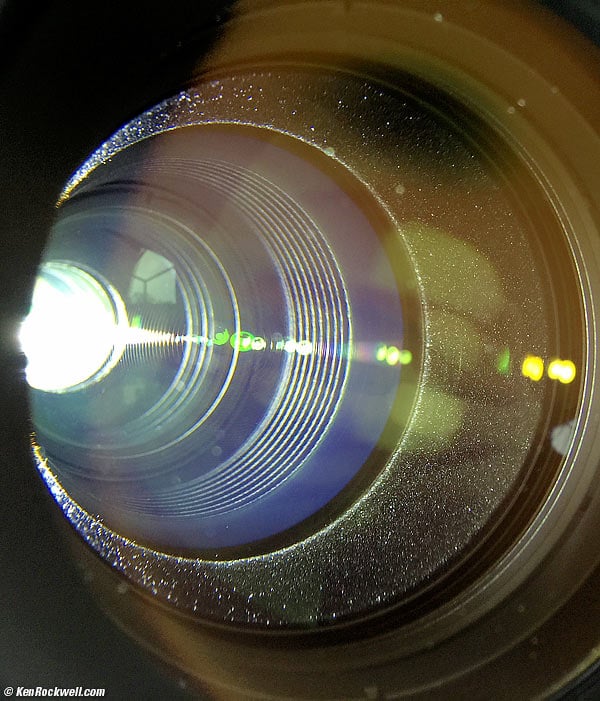
Canon 400mm f/4 DO II flashlight test.
Even shooting deliberately into the sun with dark trees in the foreground to show anything, this is the worst I could do, which is nothing:
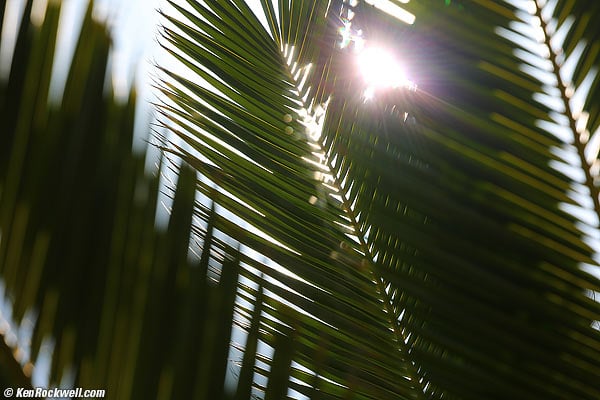
Canon 400 DO worst-case ghosts, f/8.
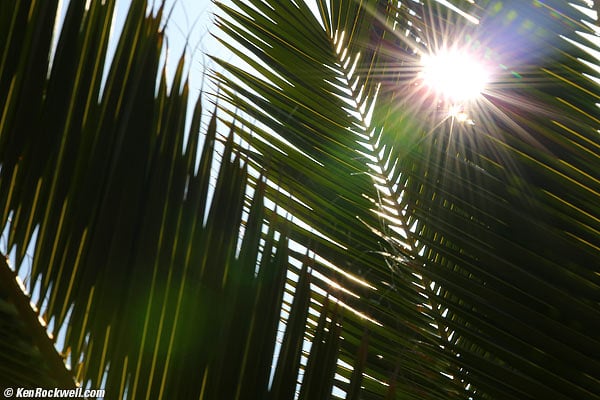
Canon 400 DO worst-case ghosts, f/32.
Remember, if sunsets are your thing that the sun is much, much less bright as it sets. In these shots, I couldn't even look through the finder because the sun was so blinding.
Focus Breathing performance top
Focus breathing (the image changing size as focused) is mostly of interest to cinematographers who don't want the image changing size ("breathing") as the lens is focused among different subjects.
The image from the 400/4 DO II gets a little larger as focussed more closely.
Lateral Color Fringes performance top
There are no lateral color fringes, even without a lens profile.
This is extraordinarily good performance.
Image Stabilization performance top
I can shoot down to about 1/20 hand held and usually get super-sharp shots. If I shoot several frames and pick the sharp one, it's not unusual for me to get a sharp shot at 1/5 of a second. This is extraordinarily good performance.
It make little to no audible sound. If I hold my ear to the lens, it can make some robotic motor sounds as it works, as well as some slight sounds when starting and stopping. It's much quieter than Canon's earliest systems.
Macro performance top
This lens doesn't get very close. Here's what you get on full-frame at the close-focus distance:
1968 Omega Constellation at close-focus distance 3.3m/11' at f/4.
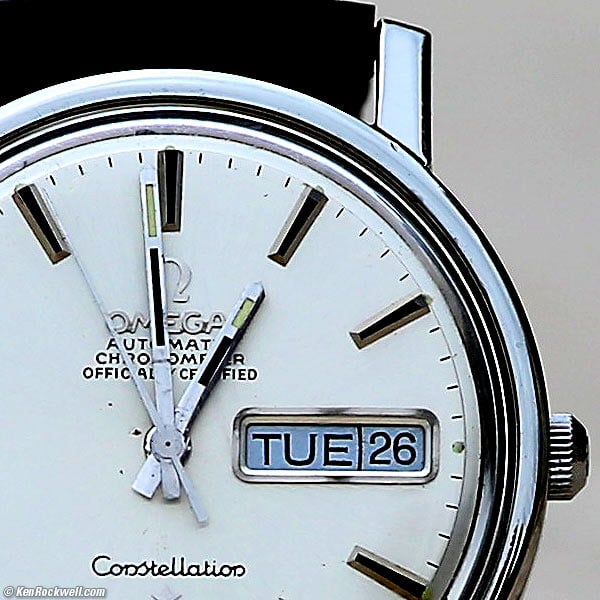
Crop from above at 100%. If this is about 6" (15cm) on your screen, printing the complete image at this same high magnification would result in a 40 x 60" (100 x 150 cm) print!
This is super-sharp, and it's wide-open at f/4.
Mechanics performance top
Rear, Canon 400mm f/4 DO IS II. enlarge.
The Canon 400mm f/4 DO II is one of the few lenses today actually built to pro standards, with an all-metal barrel.
Hood
Tough plastic.
Rubber bumper on front.
Thumbscrew lock.
Front Bumper
Rubber.
Hood Mount
Metal.
Forebarrel
Metal.
Big Knobby White Ring
Metal.
Focus Ring
Metal, rubber-covered.
Internals
Metal.
Mid Barrel
Metal.
Tripod Collar
Metal.
Rear Barrel
Metal.
Identity
Engraved metal plate.
Mount
Plated brass, with a stainless-steel insert to receive the camera's locking pin.
Markings
Painted.
Serial Number
Laser-engraved into a milled metal plate glued into a recess on the bottom of the barrel.
Date Code
None found.
Rear Gasket (moisture seal at mount)
Yes.
Noises When Shaken
Very mild clicking.
Quality
Made in Japan.
Sharpness performance top
Image sharpness depends more on you than your lens, and lens sharpness doesn't mean much to good photographers. It's the least skilled hobbyists who waste the most time blaming fuzzy pictures on their lenses, while real shooters know that few photos ever use all the sharpness of which their lenses are capable due to subject motion and the fact that real subjects are rarely perfectly flat.
The Canon 400mm f/4 is one of the few sharpest lenses made by Canon, or anyone. This 400mm is sharper than any of Canon's regular lenses, sharper than any of Canon's zooms and sharper than any of Canon's macro lenses.
If you can't get an ultrasharp image from this lens, you're doing something wrong. It could be haze or atmospheric heat shimmer, or subject or camera motion, or the simple fact that there is no depth of field at f/4 at 400mm. See also Fixing unsharp images.
It's already ultrasharp at f/4. Any stopping down will cause diffraction to dull the image at f/5.6 and smaller. This is essentially a perfect lens.
Here are Canon's MTF curves, which shows engineers just how perfect it is:

Canon EF 400mm f/4 DO IS II MTF Curve.
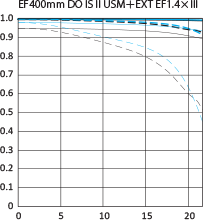
Canon EF 400mm f/4 DO IS II MTF Curve — with TC 1.4x.
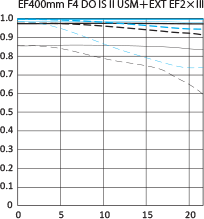
Canon EF 400mm f/4 DO IS II MTF Curve — with TC 2x.
Sunstars performance top
With its curved 9-bladed diaphragm, this Canon 400mm f/4 makes almost no sunstars on brilliant points of light unless you're at f/32.
Here's the best I could do:
Canon 400/4 DO II sunstar at f/32.
Teleconverters performance top
The 400 4 DO IS II works great with teleconverters. Focus is always fast and the combination is always ultrasharp.
The only gotcha as you add longer combinations is that autofocus may fly right by your subject at high speed and miss it. It's fine with the 1.4x and usually AOK with the 2x, but when you use both converters at the same time to make an 1,100mm f/11 autofocus lens, often my 5D Mark III may miss the target and I have to reacquire it again. It still works well; other lenses sometimes won't even try to focus while any of these combos always tries to focus and usually hits the target on the first shot.
Canon EF Extender 1.4x II
It works great with the Canon EF Extender 1.4x II, making it a 560mm f/5.6. The EXIF data reads all this correctly.
Autofocus is super fast; it's almost instantaneous It's about as good as with no convertor.
Without a lens profile, there can be an insignificantly microscopic amount of magenta-green lateral color fringes. Load a lens profile and these will go away. Even without a lens profile, it's superb:
Umbrella with Canon EF Extender 1.4x II, wide-open at f/5.6 at 1/500 hand-held. Full-Resolution.
Bokeh is beautiful with the 1.4x, too.
Canon EF Extender 2x II
The Canon EF Extender 2x II makes this an 800mm f/8. The EXIF data reads all this correctly.
The better cameras like my 5D Mark III will autofocus with the center AF sensor only.
AF is fast, but can miss the target and go right through it so you have to try again sometimes. It helps if you be sure to have the sensor on a contrasty part of the subject.
Without a lens profile, there also can be a little magenta-green lateral color fringing. Load a lens profile and these will go away. Even without a lens profile, it's so superb that I can read license plates from over a mile away, in the corners of images shot wide-open!
It's still insanely sharp wide-open with the 2x converter:
Umbrella with Canon EF Extender 2x II, wide-open at f/8 at 1/800 hand-held. Full-Resolution.
Bokeh is also beautiful; better than it looks above.
Canon EF Extender 2x II and Canon EF Extender 1.4x II
It works with both the Canon EF Extender 2x II and Canon EF Extender 1.4x II at the same time. Mount the TC-1.4x to the camera and the TC 2x to the lens and you have an 1,100mm f/11 lens!
The EXIF data is in error. It still thinks this combo is an 800mm f/8. The good news is that because of this it will autofocus with the central AF area on my 5D Mark III!
There is no real lens profile for this forbidden combination, and the combo produces a very little bit of green-magenta fringing.
The great news is not only does it autofocus quickly (even if it may miss and fly right by the target), it is still ultrasharp at 1,100mm:
Umbrella with Canon EF Extender 2x II and Canon EF Extender 1.4x II, wide-open at f/11 at 1/640 hand-held at Auto ISO 1,600. Full-Resolution.
Bokeh is also still beautiful; better than it looks above.
Compared top
Sample Images Intro Specs Performance
Compared Usage Recommendations More
See Canon 400mm Lenses Compared.
Versus 100-400mm zooms
I love my 100-400mm L II. It's smaller and lighter and focuses much, much closer than this 400 DO. My 100-400 replaced both my 70-200 and my macro lens.
This 400/4 is for someone who really needs to be at 400mm all the time, if not teleconvertered to 560mm or 800mm, at which focal lengths the 400/4 still works very well.
The 100-400 is for more conventional use where I need 100-400mm and a macro lens.
This 400mm DO is for ultra long distances where we need a 400-800mm lens.
Versus 400mm f/2.8 lenses
I own an old 15-pound autofocus 400/2.8. I haven't used it in 15 years because it's so heavy that it requires me to use both arms to carry it and its monopod around all day.
Fast f/2.8 lenses are for 35mm film, where trying to get to even ISO 200 for sports is difficult, since Velvia 50 only looks good pushed one stop from ISO 50.
For digital, f/4 is more than enough.
The reason I bought my 400/2.8 back in 1999 was so I could use extenders to make it a 560/4 and an 800/5.6, which would also autofocus with my 1999 cameras and still have enough speed to work with film.
Today, forget f/2.8 lenses unless someone else is carrying them for you to the event. f/4 is more than enough for digital, and bokeh is also superb.
Also with modern cameras, this 400/4 converts all the way up to 1,100mm and still autofocuses and lets me shoot handheld, so I have no idea why I still keep my boat-anchor 400/2.8.
Canon's modern EF 400/2.8L IS II weighs half of what my old one does(8.5 pounds/3,850g), which is a huge step forwards — but it's still twice as heavy as this new f/4 DO. Canon's EF 400/2.8L IS II also sells for $10,000 and is much bigger and longer.
We're all different, but I handhold this 400/4 all day, while there's no way I'm going to hand-hold an 8.5 pound lens for any length of time.
Versus the 300/4 IS
There's no comparison.
The 300/4 IS is an old design from 1997. Its autofocus, especially with converters, is slower, and its IS system is only about 25% as good.
While I usually get sharp hand-held shots with this 400/4 at 1/20 second, with the 300/4 IS I have to shoot at 1/60 — and 300mm is shorter than 400mm.
The 300/4 IS does focus much more closely.
Versus the 400/5.6
There's no comparison.
The 1991-era 400/5.6 has no IS, so it's more difficult to get sharp shots hand held. Forget about hand-holding it with converters.
Being a stop slower, autofocus wins no prizes with converters, and it doesn't focus as close as the 400/4.
Usage top
Sample Images Intro Specs Performance
Compared Usage Recommendations More
Teleconverters and Tele-Extenders
See my Teleconverters section above.
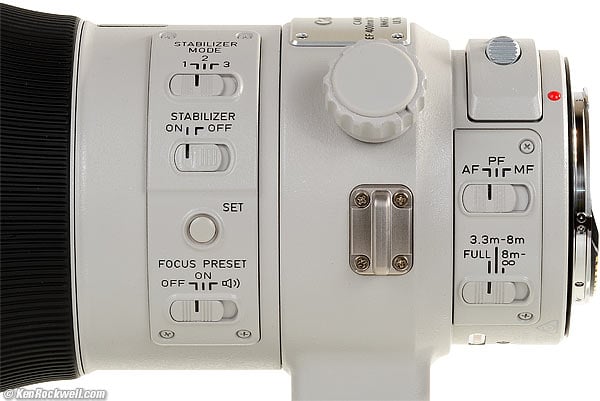
Controls, Canon 400mm f/4 DO IS II.
AF STOP buttons
The AF Stop buttons are the four black rubber buttons around the front of the lens. Press any of them to lock focus.
Tripod Collar
It doesn't come off, so I rotate mine up to get out of my way handholding.
STABILIZER
Leave it ON, except if you're on a very sturdy tripod.
MODE 1
Mode 1 is the normal mode for still photos where you're holding the camera still. it corrects for blur in all directions.
MODE 2
Mode 2 is for action photos where you are panning with a moving subject. In MODE 2 the IS system lets you move the camera in any one direction at a time and doesn't try to compensate for it. It compensates in one axis only.
MODE 3
Mode 3 only corrects at the actual moment of exposure. It may save a little battery life, but doesn't stabilize the image in the finder. It automatically guesses if you're panning and will works the same as MODE 2 during exposure.
FOCUS PRESET
This only works with the slide switch set to ON or BEEP.
If it's on, focus the lens, then tap the SET button (you'll hear it beep to confirm if you have the switch set to BEEP).
Now whenever you rotate the big white knobby metal ring on the front of the lens, the lens will immediately reset itself to your saved focus distance.
Focus Preset works the same regardless of the setting of the AF-PF-MF switch.
AF - PF - MF
AF
AF is normal autofocus. Move the rubber focus ring for instant manual override.
PF
PF is Power Focus, meaning you may focus the lens manually via silent electronic control if you move the big white knobby metal ring on the front of the lens.
The big ring is a switch, not a focus ring. Turn it just a little and the focus starts moving very slowly in or out. Move it to the stop and the lens focuses at moderate speed in or out. There are two speeds, but it takes some practice to learn where the slow speed positions are.
For this to work, Focus Preset needs to be OFF, otherwise the lens instead will zip to your preset focus point when you turn the big front ring.
You may also turn the rubber focus ring at any time for the usual manual focus. In PF, both rings work.
PF mode is mostly for shooting video.
MF
MF is manual focus.
The only way to focus the lens is to turn the rubber focus ring.
Focus Range Limiter
Use FULL. It lets the lens focus anywhere it can.
Use the 8m-∞ (26'-∞) range only if for some reason interfering elements are fooling the lens into wasting time focussing too close.
Use the 3.3m-8m (11'-26') range only if you're working close and for some reason the lens is wasting time trying to focus on far-away things.
Filter Holder
Press the two silver nubbins (near the back of the lens) towards each other and lift up the filter holder.
Leave the glass alone even with gel filters; the lens' optics need it there.
To cut a gel, first cut a 47mm square, and then cut-in 14mm straight from each corner to make an octagon.
To use a screw-in 52mm filter, buy the 52mm (W II) Screw-Type filter holder ($110).
To use a polarizer, buy the 52mm (W II) drop-in circular polarizer ($240).
Recommendations top
Sample Images Intro Specs Performance
Compared Usage Recommendations More
Birders, nature and sports shooters rejoice!
This 400/4 DO is the ultimate hand-held ultra tele. If you're a birder or sports shooter and don't have assistants carrying your gear for you, this is your lens.
It has superlative optics, a fantastic IS system and its light weight makes hand-holding a no-brainer.
It works great with extenders, even at 1,100mm, and it's hand-holdable even with all these extenders due to its light weight and superb IS system.
Great lenses are always a great investment. Unlike camera bodies, this lens will still be your top lens ten years from now, and if you tire of it, you should be able to sell it for about what you paid for it — or more. Money spend on digital bodies is money that's never coming back, while money spent on great lenses is always a great investment. (See Lens of Camera: where the smart money goes.)
If you or your friend need a long lens for actual use in the field, as opposed to just reading about it online, this is the lens to get, along with some teleextenders
If you've found my work here helpful, it helps cover my significant expenses in running this all-content, junk-free website when you get yours from these links to them at Adorama, at Amazon or at B&H.
When you use those or any of these links to my personally approved sources of supply when you get anything, regardless of the country in which you live, it helps me keep adding to this free website — but I receive nothing for these efforts if you take the chance of buying elsewhere.
Never buy at retail, especially for an exotic lens like this that everyone has probably had their hands on. Especially with this lens, anyone silly enough to buy at retail has got to know that it's going to have been taken out and played with by everyone in the store before being sold as "new;" while online orders are shipped from secure automated warehouses located far away from any store so no one else gets to drop your lens before you do. Use only the approved sources I use myself for the best prices, service, return policies and selection.
Thanks and enjoy,
Ken
More Information top
Sample Images Intro Specs Performance
Compared Usage Recommendations More
Canon USA's page on the 400mm f/4 DO IS II.
Help me help you top
I support my growing family through this website, as crazy as it might seem.
The biggest help is when you use any of these links when you get anything, regardless of the country in which you live. It costs you nothing, and is this site's, and thus my family's, biggest source of support. These places have the best prices and service, which is why I've used them since before this website existed. I recommend them all personally.
If you find this page as helpful as a book you might have had to buy or a workshop you may have had to take, feel free to help me continue helping everyone.
If you've gotten your gear through one of my links or helped otherwise, you're family. It's great people like you who allow me to keep adding to this site full-time. Thanks!
If you haven't helped yet, please do, and consider helping me with a gift of $5.00.
As this page is copyrighted and formally registered, it is unlawful to make copies, especially in the form of printouts for personal use. If you wish to make a printout for personal use, you are granted one-time permission only if you PayPal me $5.00 per printout or part thereof. Thank you!
Thanks for reading!
Mr. & Mrs. Ken Rockwell, Ryan and Katie.
Home Donate New Search Gallery Reviews How-To Books Links Workshops About Contact

